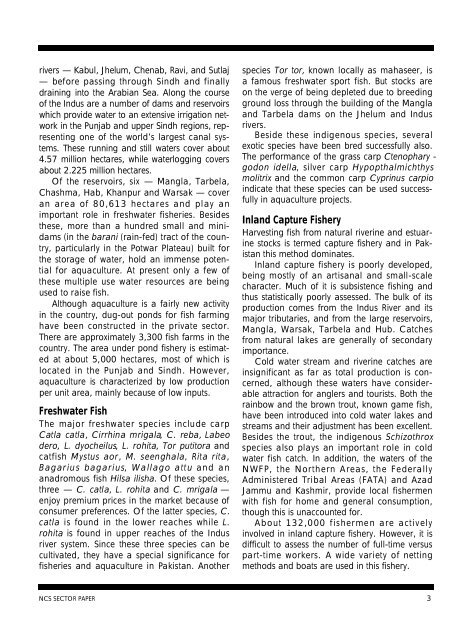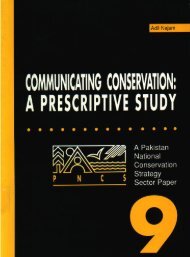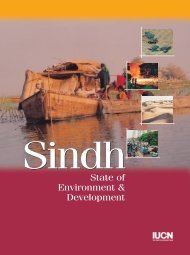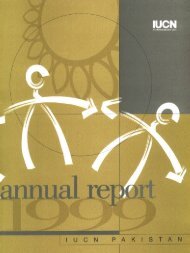Sustainable Fisheries - Pakistan Water Gateway
Sustainable Fisheries - Pakistan Water Gateway
Sustainable Fisheries - Pakistan Water Gateway
You also want an ePaper? Increase the reach of your titles
YUMPU automatically turns print PDFs into web optimized ePapers that Google loves.
ivers — Kabul, Jhelum, Chenab, Ravi, and Sutlaj<br />
— before passing through Sindh and finally<br />
draining into the Arabian Sea. Along the course<br />
of the Indus are a number of dams and reservoirs<br />
which provide water to an extensive irrigation network<br />
in the Punjab and upper Sindh regions, representing<br />
one of the world’s largest canal systems.<br />
These running and still waters cover about<br />
4.57 million hectares, while waterlogging covers<br />
about 2.225 million hectares.<br />
Of the reservoirs, six — Mangla, Tarbela,<br />
Chashma, Hab, Khanpur and Warsak — cover<br />
an area of 80,613 hectares and play an<br />
important role in freshwater fisheries. Besides<br />
these, more than a hundred small and minidams<br />
(in the b a r a n i (rain-fed) tract of the country,<br />
particularly in the Potwar Plateau) built for<br />
the storage of water, hold an immense potential<br />
for aquaculture. At present only a few of<br />
these multiple use water resources are being<br />
used to raise fish.<br />
Although aquaculture is a fairly new activity<br />
in the country, dug-out ponds for fish farming<br />
have been constructed in the private sector.<br />
There are approximately 3,300 fish farms in the<br />
country. The area under pond fishery is estimated<br />
at about 5,000 hectares, most of which is<br />
located in the Punjab and Sindh. However,<br />
aquaculture is characterized by low production<br />
per unit area, mainly because of low inputs.<br />
Freshwater Fish<br />
The major freshwater species include carp<br />
Catla catla, Cirrhina mrigala, C. reba, L a b e o<br />
dero, L. dyocheilus, L. rohita, Tor putitora a n d<br />
catfish Mystus aor, M. seenghala, Rita rita,<br />
Bagarius bagarius, Wallago attu and an<br />
anadromous fish Hilsa ilisha. Of these species,<br />
three — C. catla, L. rohita and C. mrigala —<br />
enjoy premium prices in the market because of<br />
consumer preferences. Of the latter species, C .<br />
c a t l a is found in the lower reaches while L .<br />
r o h i t a is found in upper reaches of the Indus<br />
river system. Since these three species can be<br />
cultivated, they have a special significance for<br />
fisheries and aquaculture in <strong>Pakistan</strong>. Another<br />
species Tor tor, known locally as mahaseer, is<br />
a famous freshwater sport fish. But stocks are<br />
on the verge of being depleted due to breeding<br />
ground loss through the building of the Mangla<br />
and Tarbela dams on the Jhelum and Indus<br />
rivers.<br />
Beside these indigenous species, several<br />
exotic species have been bred successfully also.<br />
The performance of the grass carp Ctenophary -<br />
godon idella, silver carp H y p o p t h a l m i c h t h y s<br />
m o l i t r i x and the common carp Cyprinus carpio<br />
indicate that these species can be used successfully<br />
in aquaculture projects.<br />
Inland Capture Fishery<br />
Harvesting fish from natural riverine and estuarine<br />
stocks is termed capture fishery and in <strong>Pakistan</strong><br />
this method dominates.<br />
Inland capture fishery is poorly developed,<br />
being mostly of an artisanal and small-scale<br />
character. Much of it is subsistence fishing and<br />
thus statistically poorly assessed. The bulk of its<br />
production comes from the Indus River and its<br />
major tributaries, and from the large reservoirs,<br />
Mangla, Warsak, Tarbela and Hub. Catches<br />
from natural lakes are generally of secondary<br />
importance.<br />
Cold water stream and riverine catches are<br />
insignificant as far as total production is concerned,<br />
although these waters have considerable<br />
attraction for anglers and tourists. Both the<br />
rainbow and the brown trout, known game fish,<br />
have been introduced into cold water lakes and<br />
streams and their adjustment has been excellent.<br />
Besides the trout, the indigenous S c h i z o t h r o x<br />
species also plays an important role in cold<br />
water fish catch. In addition, the waters of the<br />
NWFP, the Northern Areas, the Federally<br />
Administered Tribal Areas (FATA) and Azad<br />
Jammu and Kashmir, provide local fishermen<br />
with fish for home and general consumption,<br />
though this is unaccounted for.<br />
About 132,000 fishermen are actively<br />
involved in inland capture fishery. However, it is<br />
difficult to assess the number of full-time versus<br />
part-time workers. A wide variety of netting<br />
methods and boats are used in this fishery.<br />
NCS SECTOR PAPER 3
















